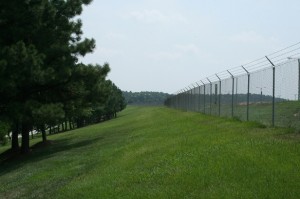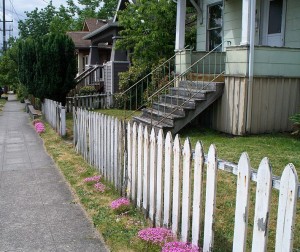Security 101: Fence yourself in!
All right, so fencing yourself in might not be such a hot idea. At the very least, you should put a gate in, just in case you want to get out some time.
In any case, choosing the right fence for your property should be among the very first bullets on your security checklist. Just like bollards, you have to decide what you want the fence to do, why you want it and what sort of message you’d like to send to whomever is likely to encounter your barrier.
[box type=”important”]Before you put up a fence, make sure your local legislation will permit you to do so! Chances are you have to apply for a permit.[/box]
Why?
The main reason for using a fence is to block access, either completely or partially. Just how a fence does this actually varies, from being a mainly psychological barrier to being a combined psychological and physical barrier. A low picket fence around a perfectly maintained lawn will discourage most people from walking on the grass, signalling to them that the activity is unwanted on a mental level.
An 8-foot steel bar fence topped with barbed wire will discourage people on a whole different level, and also provide an effective barrier against those “outliers” who are not discouraged just by the presence of a symbolic obstacle / signal. Deciding whether you need a “mental” or a physical barrier should be your first step. As a general rule, you should use the “less is more” guideline whenever possible, since people will respond better to “kinder” measures than the harsher options.
You also have to consider what you want to keep out – people or animals. Animals, obviously, need less of a barrier, since they’re generally less capable of thinking their way around (or over, or under) such things.
What?

If you’ve come this far, you probably know what a fence is. Actually, if you ever went to school, or have moved outside your house, then you probably know what a fence is. But we’ll tell you anyway – it’s just the way we roll, isn’t it?
A fence is simply a form of barrier, used to restrict the movements of either humans, vehicles or animals. It’s either a purely symbolic barrier, counting on the decency of most people, or a physical barrier that will both discourage and block attempts at traversing a border or area.
There are a whole lot of types of fences, and choosing the right one can be tricky. In general, “less is more” is a good rule here – don’t overdo things with an 8 feet tall fence and barbed wire if all you need is a white picket fence to keep the neighbor’s dog from pooping on your grass. If you put up barbed wire, then your neighbor will get pissy. If you put up a white picket fence, he’ll just think it’s cute.
Here are a few of the fence types you have to choose from:

- Chain-link fencing, wire fencing made of wires woven together
- Concrete fence
- Ha-ha (or sunken fence)
- Hurdle fencing, made from moveable sections
- Palisade
- Picket fences, generally a waist-high, painted, partially decorative fence
- Post-and-rail fencing
- Roundpole fences, similar to post-and-rail fencing but more closely spaced rails
- Slate fence, a type of palisade made of vertical slabs of slate wired together
- Spear-top fence
- Split-rail fences made of timber, often laid in a zig-zag pattern
- Stockade fence, a variation of the picket fence
- Vinyl fencing
- Wattle fencing, of split branches woven between stakes.
- Wood-panel fencing
- Wrought iron fencing, made from tube steel, also known as ornamental iron.
As you see, there are a lot of them to sort through (this doesn’t really even dent the surface of the matter…), but taking a systematic approach, we can narrow it down: What is the purpose, who do you want to hinder and how do you want it to look, are the questions you need to start with.
Where?
Anywhere, really. Use a fence to restrict access to your property, or to keep your livestock under control. Use a fence to keep your lawn perfect and free from footprints, or to make sure nobody can get to your car while you’re not around to keep an eye on it.
Fences provide for both a mental barrier, signalling to people that an area is off limits (at least without permission to enter) and a physical barrier that will deter and block attempts at entering an area that is closed to the public, either all the time or at some hours of the day or night. Having a fence should be near the top of your list of security measures, at least if you’re a land-owner. If you live in an apartment complex, then you might consider skipping the fence.
[box type=”red”]Check out our other Security 101 articles – they’re the definite starting point for anyone planning to up their security. As usual, please leave a comment – check out our awesome comment policy here![/box]

Actually, thorn hedges might be both effective and pretty barriers.
tOM